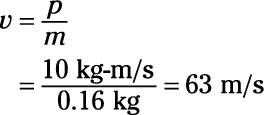Relating Impulse and Momentum
It turns out that there’s a direct connection between impulse and momentum. If you hit a pool ball with a cue, the cue imparts a certain impulse to the ball, causing the ball to end up with a particular momentum.
How can you relate impulse to momentum? Easy. The impulse you impart to an object gives it a change in momentum equal to that impulse, so
You might be confused about the units here. Impulse has MKS units of N-s, but momentum has MKS units of kg-m/s. If the units are different, then how can these two be set equal to each other? Fortunately, the units are not actually different here. Recall that 1 N = 1 kg-m/s2. This means that 1 N-s = 1 kg-m/s.
![]()
Sample question
If you hit a stationary 160.0-g pool ball with a force of 100.0 N for 0.10 seconds, what is its final speed?
The correct answer is 62 m/s.
Use the equation
Find the impulse first:
Impulse = Ft = (100.0 N)(0.10 s) = 10 N-s
That impulse is the change in the pool ball’s momentum:
![]()
Now the pool ball’s initial momentum was zero, so the final momentum is:
![]()
Momentum equals mass times velocity, so to find speed (the magnitude of velocity), you can solve for v, like so:

Practice questions
You hit a hockey puck, mass 170 g, with a force of 150 N for 0.10 seconds. If it started at rest, what is its final speed?
You’re standing on an ice rink when another skater hits you, imparting a force of 200.0 N for 0.20 seconds. If you have a mass of 90.0 kg, what is your final speed?
You kick a 450-g soccer ball with a force of 400.0 N for 0.20 seconds. What is its final speed?
You hit a 150-g baseball with a force of 400.0 N for 0.10 seconds. The baseball was traveling toward you at 40 m/s. What is its final speed?
